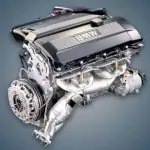The M52B20 engine appeared in 1994 and replaced the popular M50B20. This is the first representative of the new M52 family of inline 6-cylinder engines (which also includes M52B24, M52B25, M52B28, S52B32). The cylinder block of the new engine is now lightweight aluminum with nickel-plated cylinders, new pistons and connecting rods.
The length of the M52B20 connecting rod is 145 mm, the compression height of the piston is 31.64 mm. A new intake was also used, the cylinder head was taken from the M50B20TU. Injectors on M52B20 – 154 cc.
After a technical update in 1998, the engine M52TUB20 received a new cylinder head with double vanos on both shafts, the camshafts themselves are now 244/228 lift 9. Cast-iron liners appeared in the cylinder block, connecting rods, pistons, a cooling system changed, an electronic throttle valve appeared, the intake manifold received a system DISA geometry changes and more.
This motor was used on BMW cars with an index of 20i.
Specifications
| Production years | 1994-2001 Munich Plant |
| Displacement, cc | 1991 |
| Fuel system | injector |
| Power output, hp | 150 |
| Torque output, Nm | 190 |
| Cylinder block | aluminum R6 |
| Block head | aluminum 24v |
| Cylinder bore, mm | 80 |
| Piston stroke, mm | 66 |
| Compression ratio | 11.0 |
| Features | no |
| Hydraulic lifters | yes |
| Timing drive | chain |
| Phase regulator | single VANOS (M52B20) double VANOS (M52B20TU) |
| Turbocharging | no |
| Recommended engine oil | 5W-30 |
| Engine oil capacity, liter | 6.5 |
| Fuel type | petrol |
| Euro standards | EURO 2 (M52B20) EURO 3 (M52B20TU) |
| Fuel consumption, L/100 km (for E46 320i) — city — highway — combined |
12.5 6.8 8.9 |
| Engine lifespan, km | ~350 000 |
| Weight, kg | ~165 ~175 (TU) |
Disadvantages of the M52B20 engine
 The M52B20 engine is characterized by overheating, which can lead to problems with the cylinder head. If the motor is hot, check the condition of the radiator, it may need cleaning. It also helps to blow through the cooling system to get rid of air pockets. Inspect thermostat, pump and radiator cap.
The M52B20 engine is characterized by overheating, which can lead to problems with the cylinder head. If the motor is hot, check the condition of the radiator, it may need cleaning. It also helps to blow through the cooling system to get rid of air pockets. Inspect thermostat, pump and radiator cap.
When oil consumption is high, the condition of the piston rings and cylinder walls is checked. It is often sufficient to replace the rings. If the cylinder walls are worn, a nikasil motor liner is required. Also check crankcase ventilation valve.
If there are misfires in the ignition, it is necessary to replace the hydraulic lifters that have become cocked. When the engine rumbles, stalls, rpm floats, and power decreases – check if the Vanos is worn out. Repair is performed using a repair kit.
If the oil light is constantly on, check the condition of the oil cup and oil pump. Crankshaft and camshaft position sensors may fail. Among the problems are a leaking thermostat, an unreliable thread under the cylinder head bolts





